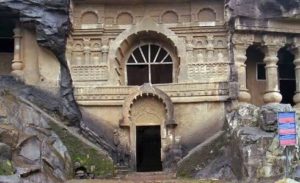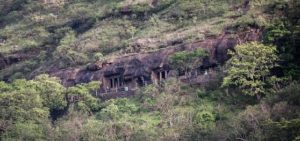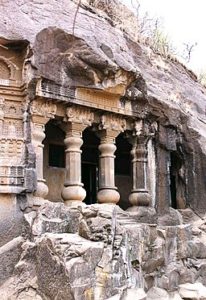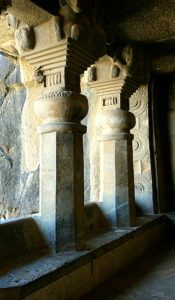
The location of the caves is a holy Buddhist site and is located about 8 km south of the center of Nashik, Maharashtra, India, on the outskirts of the city.
Trirashmi Leni (also known as Pandu caves, Pandavleni caves, or Nasik caves) (Leni is a Marathi word for caves), are a group of 24 caves carved between the 1st century BCE and the 2nd century CE, representing the Hinayana Buddhist caves and has nothing to do with the characters of Mahabharata (the Pandavas). Most of the caves are Viharas except for the 18th cave which is a Chaitya.
The caves, known as Trirashmi Buddhist Caves (erroneously known as Pandav Caves) were carved out from the 1st century BCE until the 5th century CE as a part of donation by the Buddhist Kings, merchants and local people for the Buddhist monks. The name is derived from the word “Tiranhu” which is inscribed in the Caves. It means “rays of sunlight” which is quite obvious referring to the rays of sunlight emerging from behind the Caves as seen from the village. These caves were carved and donated by various kings that ruled Nashik – The Satavahanas, The Nahapanas, The Abhirs. The caves lodge idols of Buddha and Bodhisattva. Some caves are intricately connected by stone-cut ladders that join them to the other caves. Steps lead to the caves from the bottom of the hill. The peak of the Trirashmi Caves is also accessible by trekking of about 20 mins but the path is well built with steps.

These caves are one of the oldest caves of Maharashtra. Some of the caves are large and contain numerous chambers – these rock-cut caves served as a viharas or monasteries for the disciples to meet and hear sermons. They contain interesting sculptures. One of the vihara caves is older and finer in sculptural detail and is thought to be nearly as old as the Karla Cave near Lonavala. Another cave (cave No. 18) is a Chaitya and is similar in age to the Karla Cave and has a particularly elaborate facade. Chaityas are used for chanting and meditation. The cave has idols of Buddha, Bodhisattva, sculptures representing the King, farmers, merchants and rich iconography depicting a beautiful amalgamation of Indo – Greek architecture. The site has an excellent ancient water management system and skillfully chiseled out of solid rock are several attractive water tanks.


The caves can be traced back up to the 1st century BCE. Out of the twenty-four caves, two caves are a major attraction – the main cave which is the Chaitya (prayer hall) has a beautiful Stupa; the second one is cave no. 10 which is complete in all structural as well inscriptions. Both the caves have pictures of Buddha come out of a printer stuck all over the rocks there is also no water supply there. The caves are facing eastwards. So it is recommended to visit the caves early morning as in sunlight the beauty of carvings is enhanced. The caves were called Pundru which in Pali language means “yellow ochre color”. This is because the caves were the residence of Buddhist monks who wore “the chivara or the yellow robes”. Later on, the word Pundru changed to Pandu Caves (as per Ancient Monuments Act 26 May 1909). Decades later people started calling it Pandav Caves – a misnomer which is used for every cave in India. The various inscriptions confirm that Nashik in that period was ruled by 3 dynasties – the Western Kshatrapas, the Satavahanas and the Abhiras. It seems there was always a conflict between Satavahanas and the Kshatrapas over supremacy. However, all the 3 kings fully supported Buddhism. The inscriptions also confirm that apart from the kings, local merchants, landlords too supported and donated huge sums for the development of these caves.

